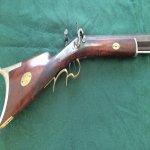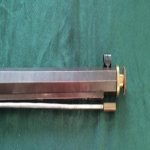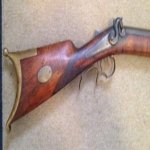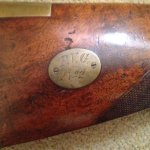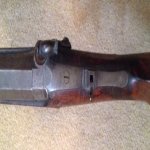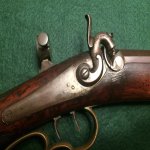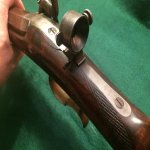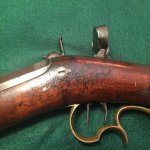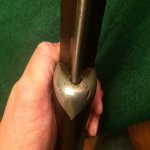Picked this up a few days ago from a estate in southern Ontario. 54 cal I have not checked to see if round ball or slug twist yet.
No makers name other than on the brass side plate
PVG No1 with bullet starter, 15.2 lbs non orig front globe sight.
I did some digging on google found another..... identical side plate PVG No2 some where in Buhl Idaho owner has passed on not sure where rifle is now.
I was able to take the barrel off from the stock, after cleaning the bottom flat I could start to read the makers name N.Lewis Troy NY
found some info on google and other sites.
Nelson Lewis Half Stock Percussion Long Rifle, made circa 1850 in Troy, New York. Nelson Lewis was born in 1811 in Speigletown, New York, north of Troy. He made a living as a market hunter, until he apprenticed with John M. Caswell in Lansingburg, NY. Lewis set up his own shop at Congress and Church Street in Troy, NY in 1843 and operated for the next 40 years, until his death on August 4, 1888. He was known for his percussion single shot and double rifles, rifle shotgun combinations, Civil War Sharpshooters’ rifles and even flintlock dueling pistols. Not only did he make high quality firearms, but he was also an excellent match shooter.
Lewis, like all the old-time gun makers, has a surprisingly small number of machines in his shop as the major part of the work in making a gun or rifle was done by hand. A boring machine for smoothing or reaming the bore of the barrels and a "rifling bench" with "rifling guide" were practically all the machines found in these old rifle-makers shops on those times. Lewis bought his barrel blanks from E. Remington & Son, using the cast steel for rifle barrels which he smooth-reamed inside, rifled, finished, fitted the lock and stocked in an excellent manner.
Lewis always cut his rifle barrels with a gain twist and absolutely refused to accept an order for a rifle to be made with a uniform twist. His "standard" type of rifling was equal width of grooves and lands and both cut with square corners.
I have examined several Lewis rifles that were rifled with quite wide grooves and narrow lands, but these are exceptions - not his regular standard rifling. If the rifle was a target gun with false muzzle, Lewis ordered the blank to be sent from the Remington factory with the pins fitted before it was sent to him and thus, in his case, the nice snug fitting pins that hold the false muzzle in place were fitted by E. Remington & Sons - not by Lewis. Lewis did not even have a lathe in his shop, but all such work as making bullet swages, bullet starters, threading the patent breech, and end of barrel was done by "Bill" Hart in his machine shop which was near Lewis' shop.
.
No makers name other than on the brass side plate
PVG No1 with bullet starter, 15.2 lbs non orig front globe sight.
I did some digging on google found another..... identical side plate PVG No2 some where in Buhl Idaho owner has passed on not sure where rifle is now.
I was able to take the barrel off from the stock, after cleaning the bottom flat I could start to read the makers name N.Lewis Troy NY
found some info on google and other sites.
Nelson Lewis Half Stock Percussion Long Rifle, made circa 1850 in Troy, New York. Nelson Lewis was born in 1811 in Speigletown, New York, north of Troy. He made a living as a market hunter, until he apprenticed with John M. Caswell in Lansingburg, NY. Lewis set up his own shop at Congress and Church Street in Troy, NY in 1843 and operated for the next 40 years, until his death on August 4, 1888. He was known for his percussion single shot and double rifles, rifle shotgun combinations, Civil War Sharpshooters’ rifles and even flintlock dueling pistols. Not only did he make high quality firearms, but he was also an excellent match shooter.
Lewis, like all the old-time gun makers, has a surprisingly small number of machines in his shop as the major part of the work in making a gun or rifle was done by hand. A boring machine for smoothing or reaming the bore of the barrels and a "rifling bench" with "rifling guide" were practically all the machines found in these old rifle-makers shops on those times. Lewis bought his barrel blanks from E. Remington & Son, using the cast steel for rifle barrels which he smooth-reamed inside, rifled, finished, fitted the lock and stocked in an excellent manner.
Lewis always cut his rifle barrels with a gain twist and absolutely refused to accept an order for a rifle to be made with a uniform twist. His "standard" type of rifling was equal width of grooves and lands and both cut with square corners.
I have examined several Lewis rifles that were rifled with quite wide grooves and narrow lands, but these are exceptions - not his regular standard rifling. If the rifle was a target gun with false muzzle, Lewis ordered the blank to be sent from the Remington factory with the pins fitted before it was sent to him and thus, in his case, the nice snug fitting pins that hold the false muzzle in place were fitted by E. Remington & Sons - not by Lewis. Lewis did not even have a lathe in his shop, but all such work as making bullet swages, bullet starters, threading the patent breech, and end of barrel was done by "Bill" Hart in his machine shop which was near Lewis' shop.
.
Attachments
Last edited:















































